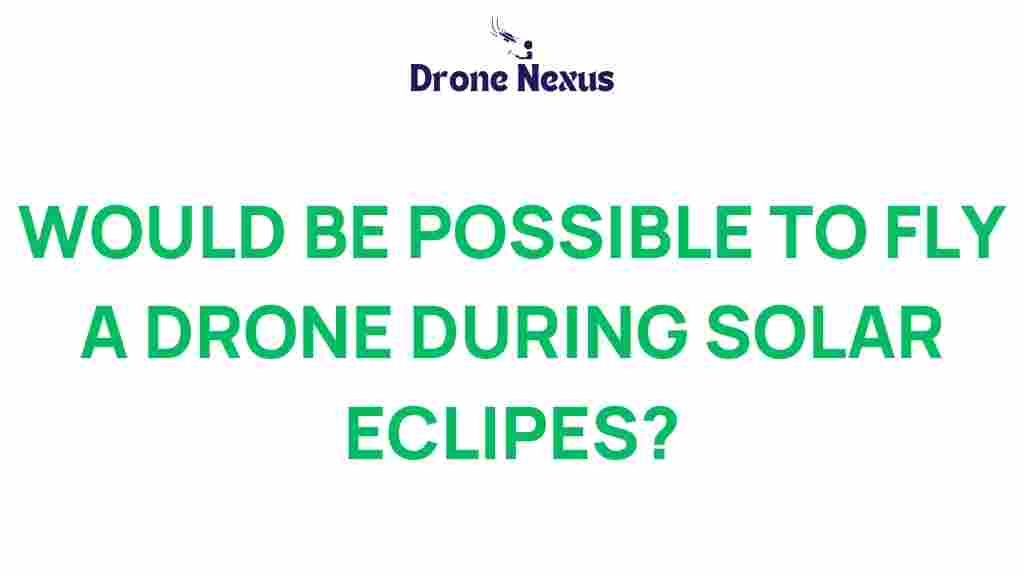Drone Safety: Can You Safely Fly a Drone During a Solar Eclipse?
As solar eclipses captivate millions around the world, many drone enthusiasts may wonder if it’s safe to fly their drones during this celestial event. While the allure of capturing stunning aerial images of a solar eclipse is understandable, there are several factors to consider, particularly concerning drone safety. In this guide, we will explore the implications of flying drones during a solar eclipse and provide essential tips to ensure that your drone flight is safe and successful.
Understanding Solar Eclipses and Their Effects
Before diving into drone safety during a solar eclipse, it’s crucial to understand what a solar eclipse is. A solar eclipse occurs when the moon passes between the Earth and the sun, blocking out the sun’s light either partially or completely. This phenomenon creates unique lighting conditions and can lead to sudden changes in the environment, which may affect drone operation.
Why Drone Safety is a Concern During a Solar Eclipse
Flying a drone during a solar eclipse poses specific risks that can compromise drone safety:
- Reduced Visibility: As the sun is obscured, the surrounding light diminishes, potentially affecting your ability to see your drone.
- Increased Crowds: Eclipses attract large gatherings of people, which can create hazards for drone operators.
- Technical Glitches: Sudden changes in weather and lighting can interfere with your drone’s sensors and navigation systems.
- Inexperienced Pilots: Many new pilots may choose to fly drones for the first time during a solar eclipse, increasing the risk of accidents.
Is It Legal to Fly a Drone During a Solar Eclipse?
Before planning your drone flight, it’s essential to check local regulations regarding drone operation, especially during special events like solar eclipses. In many countries, flying drones is subject to specific rules set by aviation authorities. Ensure you understand:
- Local airspace restrictions
- Altitude limits
- Flight bans in crowded areas
- Registration requirements for drones
For more details on drone regulations, visit the Federal Aviation Administration (FAA) website or your local aviation authority’s guidelines.
Step-by-Step Process for Safe Drone Flight During a Solar Eclipse
If you decide to fly your drone during a solar eclipse, follow these steps to ensure your drone safety:
1. Check the Weather Conditions
Before the eclipse, monitor weather forecasts in your area. Ensure that conditions are favorable for flying. Avoid areas with high winds, rain, or storms, as these can significantly impact drone stability.
2. Choose a Safe Location
Select a flying location that is away from large crowds and obstacles. This location should allow for an unobstructed view of the sky while minimizing risks to people and property.
3. Conduct Pre-Flight Checks
Prior to takeoff, conduct thorough pre-flight checks:
- Check battery levels to ensure sufficient power for the entire flight.
- Inspect the drone for any mechanical issues or damage.
- Verify GPS functionality and ensure you have a clear satellite connection.
4. Use Proper Settings
Adjust your drone settings to optimize performance during the eclipse:
- Set your camera to the appropriate exposure level to capture the changing light conditions.
- Consider using ND filters to manage light intake effectively.
- Use manual flight mode if you are experienced, as this will give you greater control.
5. Fly Responsibly and Stay Aware
During the eclipse, keep your focus on flying safely:
- Maintain visual line of sight with your drone at all times.
- Be aware of your surroundings and any people nearby.
- Monitor the drone’s battery life continuously, and be prepared to land safely before it runs out.
6. Capture Your Footage
When the moment comes, enjoy capturing the beauty of the solar eclipse. However, keep in mind that the eclipse will happen quickly, so be ready to take your shots as planned.
Troubleshooting Tips for Drone Safety During an Eclipse
If you encounter any issues while flying your drone during a solar eclipse, consider the following troubleshooting tips:
1. Loss of GPS Signal
During the eclipse, you may experience a loss of GPS signal. In this case:
- Switch to manual control if you are comfortable.
- Use your drone’s return-to-home feature to safely bring it back.
2. Sudden Weather Changes
Be prepared for unexpected weather changes during the eclipse. If you notice high winds or rain:
- Land your drone immediately if conditions become unsafe.
- Use your drone’s fail-safe features to prevent crashes.
3. Battery Issues
Keep an eye on battery levels throughout your flight. If your drone’s battery is running low:
- Immediately return to your launch point.
- Do not attempt to capture additional footage if battery levels are critically low.
Conclusion: Prioritize Drone Safety During a Solar Eclipse
Flying a drone during a solar eclipse can be an exhilarating experience, but it comes with its own set of challenges. By understanding the risks and following the necessary precautions, you can ensure that your drone flight is safe and enjoyable. Always prioritize drone safety by preparing adequately, monitoring your environment, and adhering to legal regulations. With these tips in mind, you can create stunning aerial captures while enjoying this remarkable celestial event.
For more drone safety tips and best practices, check out our comprehensive guide on drone operation safety.
This article is in the category Safety and created by DroneNexus Team
